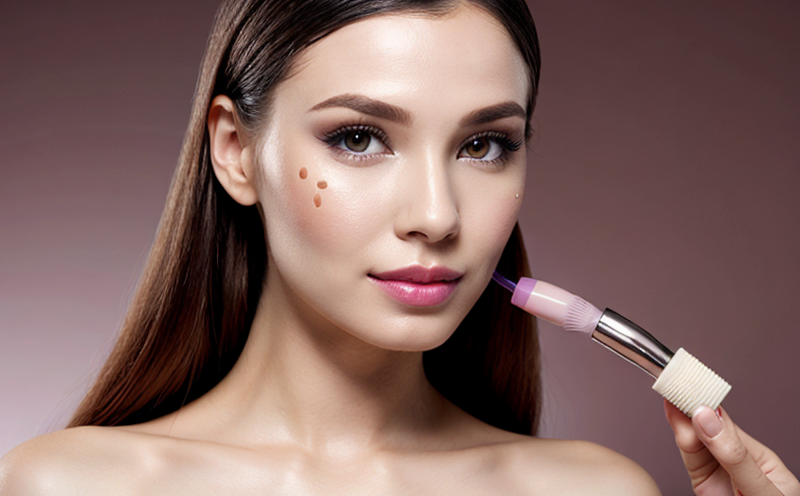Reconstructed Human Cornea-Like Epithelium Testing for Eye Irritation
The reconstructed human cornea-like epithelium (RhCE) testing is a pivotal technique used in the cosmetic industry to assess the potential eye irritation caused by new formulations. This method leverages advanced cell culture technology that mimics the structural and functional characteristics of the human corneal epithelium. By using this approach, companies can ensure compliance with stringent regulatory requirements while reducing reliance on animal testing.
The RhCE model is designed to replicate the microenvironment of the human cornea, providing a more accurate prediction of actual ocular irritation risk compared to traditional in vivo models. This test is particularly valuable for early-stage product development, allowing manufacturers to identify and mitigate potential issues before proceeding with more extensive trials or clinical studies.
One key advantage of RhCE testing lies in its ability to provide quantitative data on the degree of irritation caused by a substance. This enables formulators to make informed decisions about ingredient selection and concentration levels. Additionally, the non-invasive nature of this technique reduces ethical concerns associated with animal experimentation.
The process typically involves exposing the cultured corneal cells to the test substance under controlled conditions. After a specified incubation period, the integrity and viability of the cell layer are assessed using various methods such as live/dead staining, barrier function measurements, and microscopy analysis. These assessments help determine whether the tested compound induces cytotoxic effects or alters the permeability of the corneal epithelium.
Regulatory bodies like the European Union Cosmetics Regulation (EC 1272/2006) recognize RhCE testing as an acceptable alternative to animal-based methods for assessing eye irritation potential. Compliance with these regulations is crucial for market access and consumer trust in cosmetic products.
The implementation of RhCE testing also contributes significantly to sustainability efforts within the beauty industry by minimizing the use of live animals. As environmental awareness grows, more companies are adopting this humane approach towards product safety evaluation.
In summary, reconstructed human cornea-like epithelium testing offers a reliable and ethical means for evaluating eye irritation risks associated with cosmetic ingredients or finished products. Its precision, efficiency, and alignment with international standards make it an essential tool in modern dermatology research and development practices.
- Accurate prediction of ocular irritation risk
- Rapid turnaround times compared to animal models
- Compliance with EU Cosmetics Regulation (EC 1272/2006)
Scope and Methodology
The reconstructed human cornea-like epithelium testing encompasses a series of detailed procedures aimed at evaluating the potential eye irritation caused by cosmetic substances. The primary objective is to assess how these compounds interact with the ocular surface, particularly focusing on their ability to disrupt the corneal barrier function.
At the heart of this process are specialized cell culture techniques that aim to recreate an environment closely resembling human corneal epithelium. This involves growing epithelial cells in three-dimensional matrices which closely mimic natural architecture. The resulting layers serve as surrogate tissues capable of mimicking real-world physiological responses.
The testing protocol generally follows these steps:
- Preparation of the RhCE model by culturing human corneal epithelial cells on appropriate substrates
- Exposure of the prepared models to the test substance under standardized conditions
- Assessment of cellular changes through various analytical techniques including fluorescence microscopy, live/dead assays, and transepithelial electrical resistance measurement
- Evaluation against predefined criteria established according to relevant standards such as ISO 10993-10:2018
Throughout the procedure, strict adherence to best practices ensures accurate results that can be relied upon for regulatory submissions. This includes maintaining optimal culture conditions, employing validated analytical tools, and interpreting data consistently across all samples.
The outcome of this rigorous testing provides valuable insights into the safety profile of new cosmetic formulations. It helps identify potential hazards early in the development cycle, guiding adjustments to minimize risks without compromising efficacy or performance.
Eurolab Advantages
At Eurolab, we pride ourselves on offering comprehensive support tailored specifically for your needs regarding reconstructed human cornea-like epithelium testing. Our team of experts brings years of experience in both scientific research and practical applications to ensure that every aspect of your project receives meticulous attention.
- World-Class Laboratories: Equipped with state-of-the-art facilities designed explicitly for advanced cell culture experiments, ensuring consistent quality throughout all stages of testing.
- Comprehensive Expertise: Leveraging our extensive knowledge base covering numerous aspects of cosmetic science allows us to offer personalized advice and solutions unique to your specific requirements.
- Regulatory Compliance: Ensuring that all services comply with international standards like ISO 10993-10:2018 guarantees seamless integration into existing compliance frameworks without additional burdens on your part.
We understand the importance of delivering accurate, reliable results promptly. That’s why our team works closely with you from initial consultation through final report preparation to ensure complete satisfaction. With Eurolab by your side, you can rest assured knowing that each step in this process is handled with precision and care.
Why Choose This Test
- Ethical Considerations: By opting for RhCE testing over traditional animal models, companies demonstrate a commitment to reducing harm caused during product development. This aligns well with increasing consumer demand for cruelty-free practices.
- Precision and Accuracy: The highly controlled environment of cell cultures allows precise measurement of cellular responses, leading to more accurate predictions about actual human reactions.
- Cost Efficiency: Although initial setup costs may be higher than those associated with simpler tests, the long-term savings from avoiding costly mistakes during later stages of development can outweigh these expenses significantly.
RhCE testing stands out as a vital component in ensuring the safety and efficacy of cosmetic products. Its role cannot be overstated when it comes to meeting current and future regulatory demands while maintaining high standards for quality assurance.





